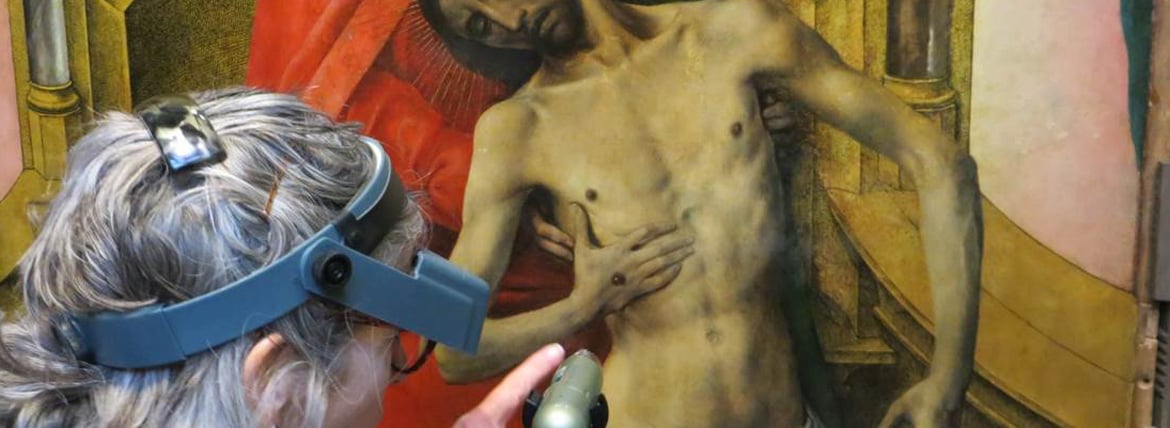
The Trinity Panels by Hugo van der Goes
Move to new location at Scottish National Gallery provides opportunity for study
Textiles
The red damask of the king’s chapelle is skilfully painted and very well-preserved. It is formed of thin layers of a transparent red glaze applied over a white or pale under-layer to reflect light back through the transparent glazes. The soft edges of the deep red pattern, where the glaze has spread just slightly as it dries, creates the impression of the soft pile of the fabric. It is possible that the artist used a stencil for this design.
The king’s sumptuous cloth of gold is created by a modelled layer of ochre and white to form the fabric falling in heavy folds. Over this, the artist has painted the red decoration in vermilion, which changes shape and direction with the folds of the fabric. In areas of shadow a red glaze of varying thickness and intensity is applied and the vermilion is left exposed in areas of highlight. The gold threads are painted in a dull ochre in the shadows, this is modulated with strokes of impasto of lead tin-yellow and white in the highlights. To add to the richness of the fabric a copper-containing green creates an additional decorative motif.
The queen’s bodice is painted in a similar fashion and the folds of her sleeve show the skilful depiction of the rich patterned fabric catching the light.
The queen’s headdress is encrusted with jewels and pearls, painted over flat areas of either orange or black paint, and built up with little touches of stiff impasto. The effect of precious gems and metals catching the light exemplifies the artist’s skill.
A very similar necklace appears in the Portinari altarpiece, worn by the donor’s daughter, Margherita, and was quite probably taken from a drawing in the artist's possession.
Bonkil’s fur is built up in a series of swift, tiny brushstrokes over a modelled grey layer, which itself is applied over a transparent orange under-layer.
Linear brushstrokes in a blueish-white and greyish-brown form the high-lit and shadowed pile of the fur. Finally, short horizontal dashes made in the still-wet paint add, remove and manipulate the paint on a very small scale in a technique approaching sgraffitto (from the Italian for scratched and more usually employed in painted decoration over gold leaf); here the artist’s skill and inventive use of paint combine to create the illusion of a rich fur.
Bonkil’s fur tails are painted over a strong orange under-layer in swift, linear strokes of dark brown paint and grey paint. The individual brushstrokes are discernible and it seems that the artist used quite a dry paint, drawing one colour into the other so thinly that the orange beneath is still visible. The final touches of blueish-white highlights and the short horizontal dashes of sgraffito are used again.
In contrast to the soft textures of the fur, the armour and sword hilt of Saint George are created by the use of precisely applied highlights built up over a modelled under-layer of a subdued colour. Tiny touches of impasto in pale yellows, or blues, create an illusion of light bouncing off a hard metallic surface, for example at the beading on the sword hilt. The final illusion is to add reflected light from the surroundings seen, for example, in the strong green of the damask reflected at the front of Saint George’s armour







